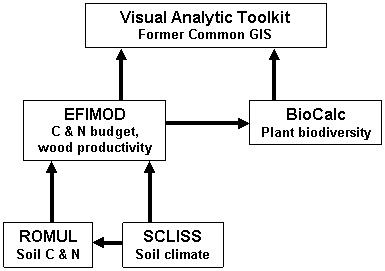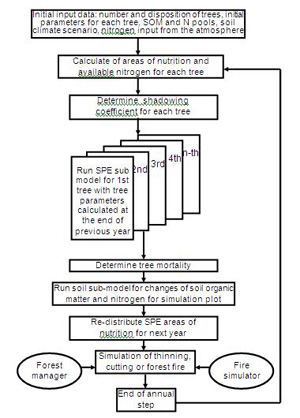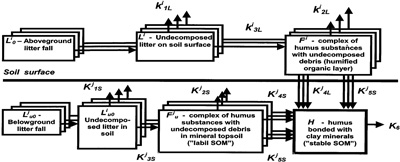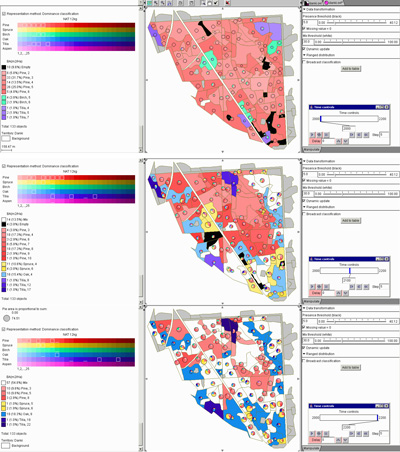Difference between revisions of "EFIMOD"
As komarov (Talk | contribs) |
As komarov (Talk | contribs) |
||
| Line 1: | Line 1: | ||
{{DSS description, Identification | {{DSS description, Identification | ||
| − | |Acronym= | + | |Acronym=EFIMOD-DLES |
| − | |Name= | + | |Name=EFIMOD-Discrete Lattice Ecosystem Simulator |
| − | |Contact person= | + | |Contact person=Alexander Komarov |
| − | |Contact email= | + | |Contact email=as_komarov@rambler.ru |
| − | |Type of the owner organization= | + | |Type of the owner organization=research institution |
| − | |Website= | + | |Website=http://ecomodelling.ru/index.php/en/models/ |
| − | |Description= | + | |Description=EFIMOD is a tool to forecast carbon and nitrogen flows in forest ecosystems with strong feedback mechanism between soil and stand. It allows for description and spatial analysis of mixed stand dynamics in boreal and temperate forests at different management and external impacts. |
| − | |References= | + | |References=Chertov et al., 1997; Chertov et al., 2001; Komarov et al., 2003; Khanina et al., 2007; Shanin et al., 2011 |
| − | |Development start year= | + | |Development start year=1996 |
| + | |Institutional framework=research prototype (R&D project) | ||
}} | }} | ||
{{DSS description, FORSYS problem types classification | {{DSS description, FORSYS problem types classification | ||
| − | |Temporal scale= | + | |Temporal scale=long term (strategic), medium term (tactical) |
| − | |Spatial context= | + | |Spatial context=spatial with neighbourhood interrelations |
| − | |Spatial scale= | + | |Spatial scale=forest level, stand level |
| − | |Decision making dimension= | + | |Decision making dimension=single decision maker |
| − | |Objectives dimension= | + | |Objectives dimension=multiple objectives |
| − | |Goods and services dimension= | + | |Goods and services dimension=market wood products, non-market services |
}} | }} | ||
{{DSS description, Utilisation scope | {{DSS description, Utilisation scope | ||
| − | |Status= | + | |Status=used (under upgrade) |
| − | |User profile= | + | |User profile=Non-industrial private owners, forest owners associations, national forest administration, NGO, local administration |
| − | |Initial deployment effort= | + | |Interoperability=none |
| − | |Adaptation effort= | + | |Initial deployment effort=<= 1 week |
| − | |Maintenance organization= | + | |Adaptation effort=plug in |
| − | |User support organization= | + | |Maintenance organization=Institute of Physico-Chemical and Biological Problems in Soil Science RAS, Institute of Mathematical Problems in Biology RAS |
| − | |Support team size= | + | |User support organization=Institute of Physico-Chemical and Biological Problems in Soil Science RAS, Institute of Mathematical Problems in Biology RAS |
| − | |Number of real-life applications= | + | |Support team size=15 |
| − | |Last utilisation year by users= | + | |Number of real-life applications=<=30 |
| − | |Typical use case= | + | |Last utilisation year by users=2011 |
| − | |Number of users= | + | |Typical use case=assessment of carbon sequestration, soil dynamics and wood production under different regimes of forest management, climate change and natural disturbances |
| − | |Utilisation in education= | + | |Number of users=<=30 |
| − | |Manual= | + | |Utilisation in education=presentation/demo |
| − | |Accessibility= | + | |Manual=No |
| − | |Deployment cost= | + | |Accessibility=restricted access |
| − | |Installation requirements= | + | |Deployment cost=<= 1‘000€ |
| − | |Country= | + | |Installation requirements=Windows 98 or higher; MDAC 2.5 |
| + | |Country=Russia | ||
| + | |Last utilised in education=2011 | ||
}} | }} | ||
{{DSS description, Functional description | {{DSS description, Functional description | ||
| − | |Species= | + | |Species=Spruce, Pine, Birch, Aspen, Lime, Oak; other species can be included after additional parametrization |
| − | |Silvicultural regime= | + | |Silvicultural regime=user defined |
| − | |Forest management goal= | + | |Forest management goal=afforestation management, biodiversity evaluation, biomass estimation, carbon sequestration, climate change impact, conservation, fertilization, fire behaviour, forest ecology, forest fuel harvesting, forest inventory, forest transformation, forest vegetation management, natural hazards, nitrate leaching, nutrient balance, silvicultural regime, yield prediction, wood supply planning, multi-functional |
| − | |Risk evaluation= | + | |Risk evaluation=N/A |
| − | |Input data requirements= | + | |Input data requirements=Climate data, Forest inventory data, Ecological data, user defined |
| − | |Modelling dimension= | + | |Modelling dimension=Forest indicators, Ecological indicators, Scenario, creation and comparison, user defined |
| − | |Planning scenario= | + | |Planning scenario=comparative analysis of multiple alternative management strategies |
| − | |Parameterised GUI= | + | |Parameterised GUI=Yes |
}} | }} | ||
{{DSS description, Models and techniques to support decision making | {{DSS description, Models and techniques to support decision making | ||
| − | |Optimisation algorithm= | + | |Optimisation algorithm=N/A |
| − | |MCDM methods= | + | |MCDM methods=N/A |
| − | |Knowlegde management methods= | + | |Knowlegde management methods=database, expert system |
| − | |Forest models= | + | |Forest models=growth models, yield models |
| − | |Ecological models= | + | |Ecological models=biodiversity |
| − | |Social models= | + | |Social models=N/A |
| − | |Data mining= | + | |Data mining=N/A |
| − | |Uncertainty evaluation= | + | |Uncertainty evaluation=frequentist statistics, Monte Carlo simulation |
| − | |2D map interface= | + | |2D map interface=Yes |
| − | |3D map interface= | + | |3D map interface=Yes |
}} | }} | ||
{{DSS description, Support for knowledge management processes | {{DSS description, Support for knowledge management processes | ||
| − | |Tool dissemination= | + | |Tool dissemination=training available on request |
| − | |Supported KM processes= | + | |Supported KM processes=N/A |
}} | }} | ||
{{DSS description, Support for participatory planning | {{DSS description, Support for participatory planning | ||
| − | |Participatory planning tasks supported= | + | |Participatory planning tasks supported=exploring options, evaluating options |
}} | }} | ||
{{DSS description, Development process | {{DSS description, Development process | ||
| − | |Number of forest specialists in the development team= | + | |Number of forest specialists in the development team=2 |
| − | |Development team size= | + | |Development team size=5 |
| − | |User access control= | + | |User access control=no |
| − | |Team profiles= | + | |Team profiles=coming soon... |
| − | |Software development methods= | + | |Software development methods=coming soon... |
| − | |User-friendliness of GUI= | + | |User-friendliness of GUI= |
| − | |Number of developer months= | + | |Number of developer months=75 |
| − | |Development cost= | + | |Development cost=>10‘000€ |
| − | |Percentage of HR cost= | + | |Percentage of HR cost=20 |
| − | |Technical documentation= | + | |Technical documentation=Yes |
| − | |Number of users on participating in specification= | + | |Number of users on participating in specification=3 |
}} | }} | ||
{{DSS description, IT environment & IT requirements | {{DSS description, IT environment & IT requirements | ||
| − | |Operating system= | + | |Operating system=Windows |
| − | |Programming language= | + | |Programming language=other |
| − | |System type= | + | |System type=stand-alone GUI, stand-alone command line |
| − | |Communication architecture= | + | |Communication architecture=COM Interfaces |
| − | |Database= | + | |Database=Access |
| − | |GIS integration= | + | |GIS integration=other |
| − | |Optimisation package= | + | |Optimisation package=N/A |
| − | |Application architecture= | + | |Application architecture=modular-based |
| − | |Format of the input data= | + | |Format of the input data=text file, database, spreadsheet |
| − | |Format of the output data= | + | |Format of the output data=text file, table, GUI, maps, 3d-visualization |
| − | |Internal data management= | + | |Internal data management=database, memory only |
| − | |Data validation= | + | |Data validation=missing/wrong data, logging facilities |
| − | |GUI technology= | + | |GUI technology=other |
| − | |Scalability= | + | |Scalability=Yes |
| − | |Spatial analysis= | + | |Spatial analysis=Outputs can be transferred to CommonGIS for spatial analysis |
| − | |Related tools= | + | |Related tools=CommonGIS |
| − | |Integration with other systems= | + | |Integration with other systems=no |
| − | |Computational limitations= | + | |Computational limitations=none |
}} | }} | ||
{{DSS description, Commercial information | {{DSS description, Commercial information | ||
| − | |Can be used commercially= | + | |Can be used commercially=No |
}} | }} | ||
| − | |||
== General System description == | == General System description == | ||
Revision as of 13:27, 21 October 2011
Template:DSS description, Identification Template:DSS description, FORSYS problem types classification Template:DSS description, Utilisation scope Template:DSS description, Functional description Template:DSS description, Models and techniques to support decision making Template:DSS description, Support for knowledge management processes Template:DSS description, Support for participatory planning Template:DSS description, Development process Template:DSS description, IT environment & IT requirements Template:DSS description, Commercial information
General System description
System name: EFIMOD-Discrete Lattice Ecosystem Simulator
Acronym: EFIMOD-DLES
Brief overview
EFIMOD is a tool to forecast carbon and nitrogen flows in forest ecosystems with strong feedback mechanism between soil and stand. It allows for description and spatial analysis of mixed stand dynamics in boreal and temperate forests at different management and external impacts.Contents
Scope of the system
The tool provides information to assess forest/soil natural development, forest/land-use management, and different scenarios of external impacts.
System origin
It was developed by a researchers’ team in the Institute of Physico-Chemical and Biological Problems in Soil Science (Pushchino, Russia) and Biological Institute of Sankt-Petersburg State University with support of European Forest Institute (Joensuu, Finland) and Joensuu University (Joensuu, Finland). First prototype was implemented in 1996 being not a commercial product and based on earlier models by O.Chertov. The tool has been applied in Russia, Finland, Sweden, Canada, the Netherlands, Bulgaria, Czech Republic, and in several international projects (three projects in INTAS EU Program, FP5 EU-Programme Project CT98-4124 “Relationships Between Recent Changes of Growth and Nutrition of Norway Spruce, Scots Pine, and European Beech Forests in Europe (RECOGNITION)”, FP6 EU Programme INCO - 013388 “Impacts and risks from anthrpogenic disturbances on soils, carbon dynamics and vegetation in podzolic ecosystems (OMRISK)” and other projects. It has been implemented also for several applications in frame of the National Program of Russian Academy of Sciences “Change of Environment and Climate”.
Support for specific issues
The system is designed to take into account timber harvest effects, dynamics of ecosystem and forest understorey biodiversivity, climate change effects, landscape analysis methods, nitrogen deposition effects, and fires.
Support for specific thematic areas of a problem type
- Silvicultural
- Conservation
- Restoration
- Development choices / land use zoning
- Sustainability impact assessment (SIA)
Capability to support decision making phases
In current version, the GUI helps the user to compare dynamics of ecosystem parameters (e.g. growing stock, stand and soil carbon and nitrogen pools, biodiversity ranks etc.) at different scenarios of forest management and other external impacts.
Related systems
Data and data models
Typical spatial extent of application
The application can be used on regional, forest-enterprise, and forest stand scale.
Forest data input
The system uses stand-level inputs from forest inventory database, the pools of soil organic matter and nitrogen in different soil layers, and climatic and hydrological data. Detailed list of input parameters you may find at EFIMOD-DLES webpage.
Type of information input from user (via GUI)
User may define the scenario of forest ecosystem development via specifying various management options, such as different types of cuttings, plantings etc.; external impacts, such as fires, climate change, different levels of nitrogen deposition. For biodiversity assessment, regional phytosociological data is required.
Models
Forest model
The modelling tool of forest ecosystem EFIMOD [1][2][3] is an individual-based spatially explicit simulator of tree-soil system that calculates parameters of carbon balance and standard forest inventory characteristics: NPP, Rh, soil available nitrogen, tree and stand biomass by tree compartments, soil organic matter (SOM) and N pools, stand density, height, DBH, growing stock and some other parameters. It includes soil model ROMUL as an important component[4] that is driven by soil water, temperature and SOM parameters. The statistical generator of soil climate SCLISS was compiled to run ROMUL. The EFIMOD allows for a calculation the effect of silvicultural operations and forest fires. Now it is linked with a system of plant biodiversity assessment BioCalc.
Soil model
The ROMUL model[5][6] of soil organic matter (SOM) and nitrogen mineralisation and humification calculates the transformation of litter and SOM compartments, the gross carbon dioxide flow from the soil due to SOM mineralisation and the nitrogen available for plant growth. The rate of litter and SOM mineralisation and humification is dependent on the litter quality, soil temperature and moisture, and on some soil parameters. The model validation and sensitivity analyses had been performed using a set of published laboratory and field experiments[7][8][9].
Climate model
A soil climate generator SCLISS[10] is used in the model for two purposes: (1) as a method of evaluation of soil temperature and moisture using measured standard meteorological long-term data; (2) statistical simulation (generation) of realisations of long-term series of necessary input climate data with known statistical properties. The model uses monthly average data on air, litter and soil temperature, precipitation, litter and mineral soil moisture.
Model of biodiversity
A model BioCalc (BIOdiversity CALCulator) forecasts dynamics of ecosystem and species understorey diversity of each forest unit along the EFIMOD simulation outputs on a base of standard forest inventory data linked with the results of detailed phytosociological research [11].
More detailed description of models you may find at EFIMOD-DLES webpage.
Decision Support
Definition of management interventions
The manager can intervene in the forest: time of harvest, plantations, thinnings, selective cuttings, natural regeneration, converting of forest into agricultural lands and back.
Typical temporal scale of application
The system allows for short-term prognosis (e.g. rotation period) and long-term prognosis (e.g. several generations of tree species) with annual temporal resolution.
Types of decisions supported
- Management level
- strategic decisions
- operating control decisions
- planning decisions
- organizing decisions
- coordination decisions
Decision-making processes and models
- Logic modeling
- Heuristic manipulation of simulation models
- Simulation (with and without stochasticity)
Output
Types of outputs
Results are reported as tables, maps, graphs, stand-level 3-D visualizations.
Spatial analysis capabilities
The system is linked to CommonGIS.
Abilities to address interdisciplinary, multi-scaled, and political issues
The system produces coordinated results for decision makers operating at different spatial scales, facilitates social negotiation and learning.
System
System requirements
- Hardware requirements: 1GHz x86 CPU, 256Mb RAM, 50Mb disk space.
- Operating Systems: Windows 98/2K/XP/Vista.
- Other software needed: the user does not need to acquire additional software.
- Development status: completed.
Architecture and major DSS components
The system is a set of desktop Win32-applications.
Usage
Research and regional administration level.
Computational limitations
Run time is impacted by the number of management units.
User interface
The system has a standard Windows GUI. Use of the system requires basic forestry and soil science background.
Documentation and support
English version of user manual is now in progress.
Installation
The system is completely portable: no special installation is required.
References
Cited references
- ↑ Chertov, O.G. Komarov, A.S., Tsiplianovsky, A.V. 1999. A combined simulation model of Scots pine, Norway spruce and Silver birch ecosystems in European boreal zone. Forest Ecology and Management 116: 189-206.
- ↑ Komarov, A., Chertov, O., Zudin, S., Nadporozhskaya, M., Mikhailov, A., Bykhovets, S., Zudina, E., Zoubkova. 2003. EFIMOD 2 - - A model of growth and elements cycling in boreal forest ecosystems. Ecological Modelling 170 (2-3): 373-392.
- ↑ Komarov, A.S., Chertov, O.G., Mikhailov, and Autors’ Collective (14 names). 2007. Modelling Dynamics of Organic Matter in Forest Ecosystems [Responsible editor V.N. Kudeyarov]. Nauka, Moscow. 380 p. In Russian with English contents. ISBN 5-02-034053-7.
- ↑ Chertov, O.G. Komarov, A.S., Nadporozhskaya, M.A., Bykhovets, S.A., Zudin, S.L. 2001. ROMUL – a model of forest soil organic matter dynamics as a substantial tool for forest ecosystem modelling. Ecological Modelling 138 (1-3): 289-308.
- ↑ Chertov O.G., Komarov A.S. 1997. SOMM -- a model of soil organic matter dynamics. Ecological Modelling 94(2-3): 177-189.
- ↑ Chertov, O.G. Komarov, A.S., Nadporozhskaya, M.A., Bykhovets, S.A., Zudin, S.L. 2001. ROMUL – a model of forest soil organic matter dynamics as a substantial tool for forest ecosystem modelling. Ecological Modelling 138 (1-3): 289-308.
- ↑ Chertov O.G., Komarov A.S. 1997. SOMM -- a model of soil organic matter dynamics. Ecological Modelling 94(2-3): 177-189.
- ↑ Chertov, O.G. Komarov, A.S., Nadporozhskaya, M.A., Bykhovets, S.A., Zudin, S.L. 2001. ROMUL – a model of forest soil organic matter dynamics as a substantial tool for forest ecosystem modelling. Ecological Modelling 138 (1-3): 289-308.
- ↑ Komarov, A.S., Chertov, O.G., Mikhailov, and Autors’ Collective (14 names). 2007. Modelling Dynamics of Organic Matter in Forest Ecosystems [Responsible editor V.N. Kudeyarov]. Nauka, Moscow. 380 p. In Russian with English contents. ISBN 5-02-034053-7.
- ↑ Chertov, O.G. Komarov, A.S., Nadporozhskaya, M.A., Bykhovets, S.A., Zudin, S.L. 2001. ROMUL – a model of forest soil organic matter dynamics as a substantial tool for forest ecosystem modelling. Ecological Modelling 138 (1-3): 289-308.
- ↑ Khanina, L., Bobrovsky, M., Komarov, A., Mikhajlov, A., 2007. Modelling dynamics of forest ground vegetation diversity under different forest management regimes. For. Ecol. Manage. 248: 80-94
External resources
- http://ecomodelling.ru/index.php/en/models/ - description of EFIMOD-DLES





